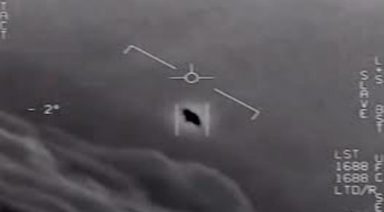Deeper Space: Episode 2

EPISODE 2: MYSTERIES OF THE SOLAR SYSTEM
For many, making contact with beings from other worlds remains only a topic for ghost stories, teenage goths, or perhaps an innocent parlor game with a dusty Ouija board.
Since ancient times, contact with other worldly beings was understood as a source of privileged information for Mortals. In ancient Greek culture, the Muses inspired mortals with insights into the arts and sciences. Across the globe, diviners and mediums became portals of communication between the living and entities that crossed to the other side.
Is there a deeper meaning and history to practices such as séances, automatic writing and channeling by mediums?
SPIRITUALISM, TECHNOLOGY AND POST-WAR CULTURE
Activities channeling otherworldly beings were a widespread phenomenon in Europe following new developments in psychology outlined by revolutionaries such as Sigmund Freud and Carl Jung. Social interest in channeling, séance, parapsychology and automatic writing began in the Victorian era and continued after WWII.
Following the devastation of WWI, devout Christian and Catholic families indulged in private channelings of spirits of their departed loved ones. Fascist parties such as the Italian black shirts and the Nazi Party, who reunited nationalism with mysticism, further manifested these practices. Italian fascists and Nazis alike indulged in what, in today’s terms, would be perceived as ritualistic and heretic.
Nazis practiced many ritualistic activities, which ranged from mass initiations to baptizing their swastika flags (known as Blutfahne) in blood of fallen martyrs. The connections between occult studies and the Nazi party extended beyond Hitler’s embrace of Helena Blavatsky’s premonition that an “Aryan race” (a misused term; the Aryans are in fact individuals of Persian heritage) would emerge as the dominant people of a new age. Germans sought mystical objects, looted art and attempted to rewrite their history into myth. For Italians and Germans, fascist culture sought to unite the future with the values and symbols of their ancient pasts.
Curiously, twentieth century occultism often attracted a strong connection to technology. For example, Italian fascists extended funding and patronage to an artistic group known as the Futurists. This entourage of extreme nationalistic poets and artists extolled death, machines, and war. Within their poetry and art, Futurists dreamed of a future where machine and man fused as one. Within the work of this collective we begin to see early concepts of cyborgs and Transhumanism.
On the other hand, the German National Socialists dreamed of rebuilding a modern Germania. Hitler and Speer planned to redesign Berlin as a futuristic neo-classical utopia connected by a hyper speed network of roads, which today we know as the Autobahn. The Germans were and are today known for their skill in design and engineering, and their Luftwaffe was unsurpassed by the Allies during WWII. Is it possible they had help?
The narrative concerning German medium Maria Orsic remains an obscure footnote in the studies of modern history and that of the occult interests and esoteric studies embraced by the Third Reich.
Mysteries of the Solar System
Our solar system was once the staging ground for an ancient progenitor civilization which left behind a trail of interstellar bread crumbs for us to follow. This may be seen in the writings of Philip K. Dick, the Black Knight satellite and in the channeled writings of Maria Orsic.
WHO WAS MARIA ORSIC?
Maria Orsic was a member of a German occult society known as the Vril. The Vril belonged to a network of exclusive groups including the Thule Society and the Order of the Black Sun. Vril originated from the Latin “virile” and from esoteric texts such as Sir Edward Bulwer-Lytton’s The Coming of the New Race (1872), in which Vril signifies power, light force and supernatural ability.
These concepts mirror Madame Blavatsky’s theosophical work The Secret Doctrine (1888) in terms of its prophetic motive. The Vril united a sisterhood of mediums, who facilitated private séances for the German elite.
However, Maria Orsic made contact with beings beyond the realm of the dead. In 1919, an inner circle of the Vril and Thule societies gathered in Ramsau, Austria for private meeting. In this congregation, Maria Orsic presented strange transcripts of her communications with entities from Aldebaran, a star in the Taurus constellation.
According to her contemporaries, Maria channeled these entities and recorded the encounter via automatic writing. During these sessions, Orsic penned verses in Sumerian with accompanying sketches of saucer-like spacecraft. Additionally, the beings gifted Maria with the wisdom to harness free energy and to build a utopia free from greed over natural resources. Supposedly, the Nazi party intercepted this contact to benefit their need for military innovation. Maria’s aircraft designs were developed into prototypes and were later adapted with other technologies gathered from antigravity research by scientists such as Viktor Schauberger.
What happened to Maria Orsich and the Vril society remains unknown, but many speculate the group continued its legacy into space programs today. In fact, NASA rocket scientists such as Dr. Hermann Oberth confessed they received help from people from other worlds.
Are there others who have been contacted?
Maria Orsic, The Vril & UFOs
Who was Maria Orsic and what does she have to do with the Vril Society? Uncover the mystery of this secret society and their key role Nazi Germany.
PHILIP K. DICK AND VALIS
American novelist Philip K. Dick involuntarily became another interstellar medium. Dick published 44 novels and over 100 short stories. Many of these science fiction works were adapted to film and television, such as Blade Runner, Total Recall, and Minority Report.
One of the most recent adaptations, The Man in the High Castle, was recently adapted into a 2015 TV series. In 1974 Philip K. Dick experienced what some would call psychosis or insanity.
Following a routine wisdom tooth removal, the science fiction author took a large amount of sodium pentothal. At home, Dick received a vision of his past life as an early Christian. Soon after, a beam of pink light or plasma penetrated the author’s consciousness and transferred critical information concerning his son’s undetected hernia.
These experiences continued, and after several years of serious contemplation Philip K. Dick documented his experience in a series of novels concerning artificial intelligence, reality, and consciousness beginning with the text VALIS.
VALIS (an acronym for Vast Active Living Intelligence System) is Philip K. Dick’s semi-autobiographical novel published 1981. Not unlike Herman Hesse’s Harry Haller in Steppenwolf (1927), Philip K. Dick created an alter ego called Horselover Fat who suffers an existential mental collapse parallel to a midlife crisis.
VALIS begins as a very commonplace storyline; a man stuck in the middle of the rotting fallout the 1960s in San Francisco. Surrounded by drug addiction and death, Horselover Fat encounters a divine plasmate, a neologism for “living knowledge,” and consequently insanity. VALIS documents the author/protagonist’s revelations about God, humanity, and reality. As Fat’s divine revelations develop, he assembles a following of disciples that aid his pursuit for uncovering the source of existence.
Throughout this process of Seeking Truth, Horselover Fat considers several causes for his religious experience: schizophrenia, pharmaceutical psychosis, and direct communication with an alien satellite.
All three possibilities suggest a synthetic reality cloaking all human perception.
VALIS is not so much a work of science fiction, but rather an abstracted memoir that tapped into an esoteric movement called Gnosticism.
Philip K. Dick, Valis, Precogs, and The Evolution of Humanity
Philip K. Dick’s interactions with Valis prompted him to become one of the most prolific science fiction writers ever, but was it actually biography?
WHAT IS GNOSTICISM?
In his novel, Dick offers a definition of Gnosticism for those unable to reconcile their belief in God and the state of their world: “In Gnosticism, man belongs with God against the world and the creator of the world (both of which are crazy, whether they realize it or not.)” In the digital and secular age, questions of purpose and reality continue a trajectory of skepticism and religious extremism across the globe. VALIS and major motion pictures such as Blade Runner (1982), The Matrix (1999), Dark City (1998) became part of a continuing dialogue and growing interest in Gnostic concepts.
Gnosticism is a school of thought that believes that transcendence is possible through intuition and personal religious experience outside established systems of theology or philosophy.
Where religions such as Buddhism and Christianity blame human nature as the source of universal suffering, Gnostics believe that a manipulative creator or demiurge imposes our imperfect reality. The demiurge however is subordinate to a supreme being that creates no illusionary existence but is purely spiritual in essence.
It cannot be said that Gnosticism remains completely separate from organized religion. There are in fact Gnostic Christians who see the Bible and the Trinity as conduits for Gnosis or insight. Within the VALIS series, Philip K. Dick contemplates his epiphany through a Christian lens. The 1981 edition of the novel published by Corgi, in which a supine Christ flies over earth as a jet-powered satellite, best illustrates this concept.
Some believe that an ancient extraterrestrial (ET) satellite known as the “Black Knight” targeted Philip K. Dick. This UFO remains a point of discussion between believers and skeptics. Not only do researchers believe this object to be of ancient origins, but its suggestively Masonic name implies a connection to an order within the Thule society known as the Black Knights.
The appearance of the Black Knight suggests that otherworldly influences on human consciousness may originate within our own solar system.
What recent discoveries in space exploration challenge our perspectives of existence, humanity, and significance in the universe?
What is Gnosticism?
From Goddess creation mythology to alchemical gold, Gnosticism has deeply influenced Western spirituality. Explore the deep world of gnosticism.
INTERSTELLAR DISCOVERIES AND ALTERNATIVE HISTORIES
In our own solar system, one can find anomalies that challenge our perspective of the universe. One such mystery is the Titus-Bode Law. This law hypothesizes that every planet is twice as far from the sun as the previous planet. This is true except for the distance between Mars and Jupiter and the distance between Uranus and Neptune.
Between Mars and Jupiter is an asteroid belt. Some believe that this asteroid belt is the remnants of a destroyed ancient Planet.
Given its position in the solar system this possible planet might have sustained organic and intelligent life. Researchers such as Linda Moulton Howe and John Brandenburg consider the possibilities of extraterrestrial life as former neighbors in the galaxy rather than light-years away from earth.
Brandenburg especially examines the chemical and elemental profiles of Mars in comparison to our planet. Brandenburg discovered that the isotope mass of Xenon 129 on Mars is astronomically denser than that of Earth. It is doubtful that these density levels could have naturally occurred but are the result of detonated nuclear weapons. Recently, NASA’s examination of Saturn’s moon Iapetus raises even more questions.
 *Image courtesy of Wikipedia.
*Image courtesy of Wikipedia.
In 2014, NASA released high definition photos of this moon’s equatorial ridge, which goes all the way around and consists completely of straight edges. This six mile high wall suggests that Iapetus is an artificial satellite of mysterious origins.
DIVING DEEPER
As we explore other episodes of Deep Space it is best to keep in mind how these cultures, attitudes and thinkers did not die with the fall of the Third Reich but continued their presence into NASA. German scientist joined forces with the US space program after the war, and even former SS member Werner Von Braun became the director of the Marshall Space Flight center.
Maria Orsic, Adolf Hitler, Rudolf Hess, and Werner Von Braun form a constellation of individuals practicing scientific and esoteric studies which took seed in the new world. From Freemasonry to Scientology, occult symbolism and culture in America can be traced back to its 19th and 20th century roots in Western Europe. In the next episode of Deep Space we will explore the Nazi takeover of experimental extraterrestrial technology for personal gain in “German Saucers.”
DEEP SPACE EPISODE 2 READING LIST
For a concise summary of Philip K. Dick’s Gnostic vision please explore “The Religious Experience of Philip K. Dick,” a 1986 Comic by Robert Crumb from the magazine Weirdo. Also, explore a recent publication of Dick’s journal entries in The Exegesis of Philip K. Dick (2011)
Recently the 2014 book Gnostic America by Peter M. Burfeind connects reconstituted ancient Gnostic concepts with contemporary American culture. Burfeind suggests that this phenomenon is a result of a spiritual vacuum as well as the absence of modern myth i.e. mankind’s journey into the unknown
Explore Philip K. Dick’s VALIS Trilogy: VALIS (1981), The Divine Invasion (1981), and The Transmigration of Timothy Archer (1982).
To learn more about occult practices, symbols, and histories hidden in plain sight, pick up a copy of Occult America: White House Séances, Ouija Circles, Masons, and the Secret Mystic History of Our Nation (2010) by Mitch Horowitz
For a more scholarly text check out Black Sun: Aryan Cults, Esoteric Nazism, and the Politics of Identity (2003) by Nicholas Goodrick-Clarke. This rich work unpacks the secret occult history of fascist practices and makes a strong argument that German and Austrian secret societies became organized proto-fascist groups.

NASA Developing Robotic Bees to Collect Samples, Map Mars Surface

NASA’s Mars rovers have gathered a lot of exciting data and photographs, but they’re moving at a snail’s pace. So how will it expedite that process? Robotic bees.
The space agency is developing bee-sized robots to map the surface of Mars and collect samples from the planet’s atmosphere. Scientists hope these insectoids will be more mobile and agile than traditional rovers.
The program, called “Marsbees,” is contracting researchers from the U.S. and Japan to build prototypes of winged robots, capable of swarming the red planet and collecting data, before returning to a rover to recharge.

Image courtesy uah.edu
One of the biggest obstacles engineers face is designing a robot that can fly in Mars’ unique climate. The red planet’s atmosphere can be pretty hostile with dust storms, low thermal inertia, and periodic ice ages. These bees will inevitably face some extreme weather conditions.
But there is one factor that may make the mission easier – Mars’ gravitational pull is about a third of Earth’s, which could prove to be more conducive to flight.
NASA’s website envisions the robots as roughly the size of a bee, but with larger, cicada-sized wings. Researchers imagine the bees will be capable of working independently or in teams to collect samples.
The program funding the project is called the NASA Innovative Advanced Concepts Program, or NIAC, which fosters science fiction concepts with the potential for realistic applications.
The aerial bots would primarily search for methane emissions from below the planet’s surface – an indication of subterranean Martian life. NASA’s Curiosity rover previously discovered low levels of the gas, encouraging scientists to explore further.
But the technology for this apian concept doesn’t have a lot of promising precedent. Several years ago, DARPA built a hummingbird-inspired drone, with a multi-million-dollar budget. Researchers engineered it to fly steadily, but the winged machine would likely struggle in the Martian environment.
Engineers working on the Marsbees prototype will test their robots in a vacuum chamber, with conditions to simulate the climate and air density on Mars. The group is receiving just $125,000 over the course of nine months to fund their prototype, before it will be tested for feasibility by NASA. If it passes preliminary tests, it will then be eligible for a second round of funding.







































